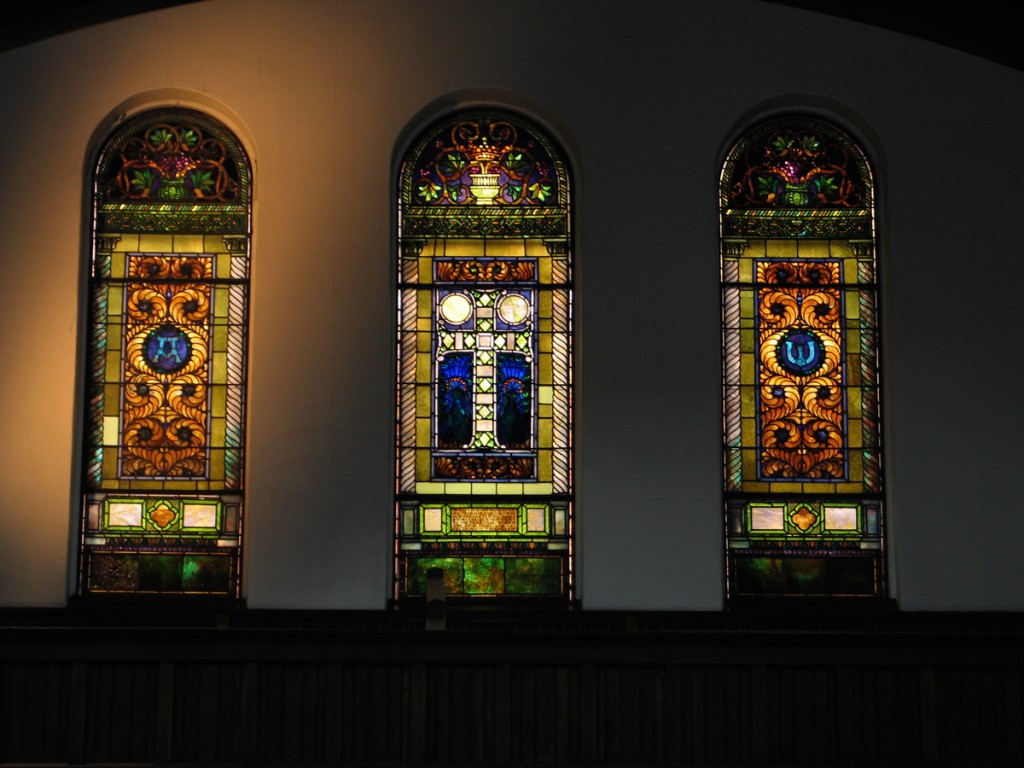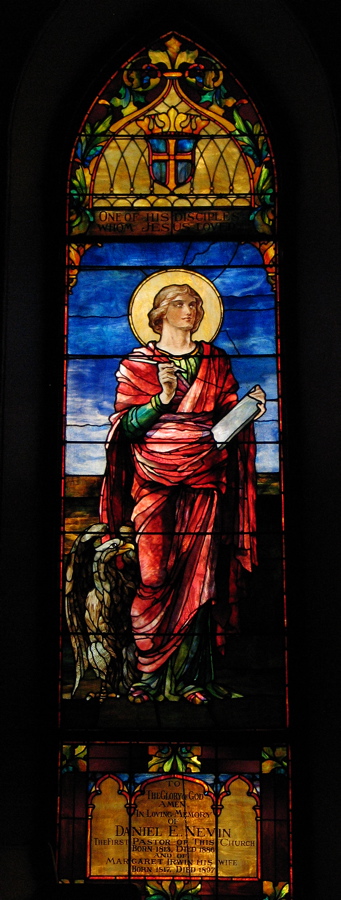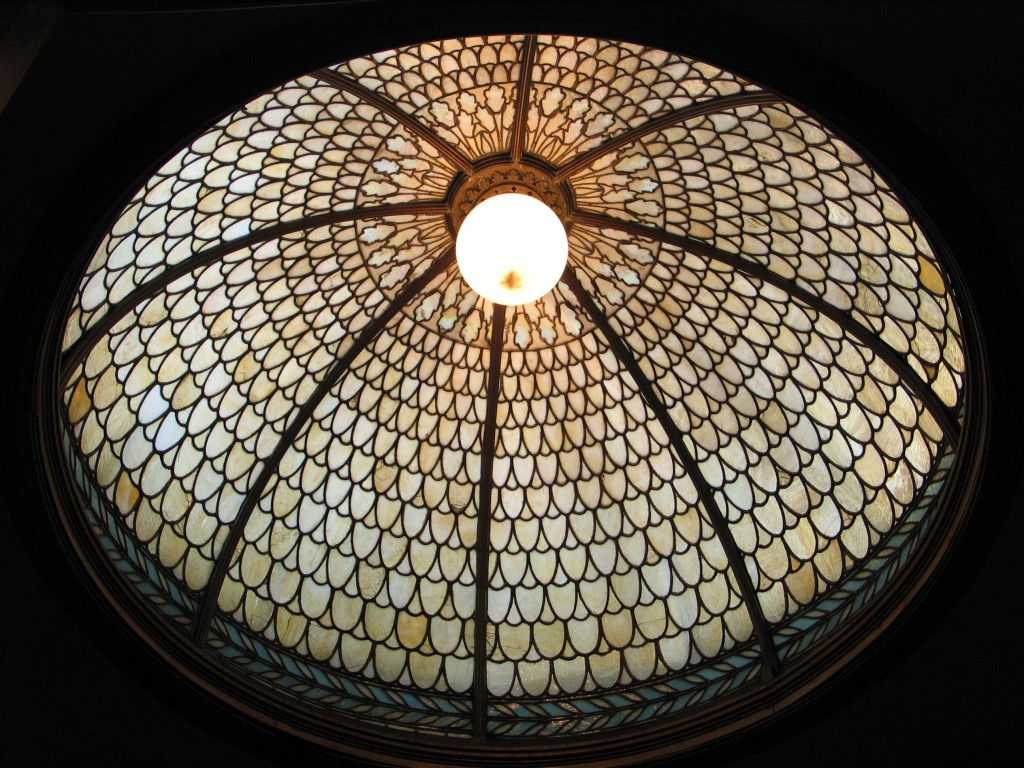
Architectural Glass in Pittsburgh
Series 2: Tiffany Windows in Western Pennsylvania
Albert M. Tannler, Historical Collections Director,
Pittsburgh History & Landmarks Foundation
INTRODUCTION
Mr. Tiffany’s Oriental leanings are well-known. He is in favor of the boldest, strongest, most telling method. He never hesitates to join cloth of gold to cloth of frieze, to inlay rough-cast with fine marbles, or to use the cheapest along with the most gorgeous glass, when an artistic result may be secured. He is without any touch of the “literary sort of thing.” He speaks . . . through the eye to the mind and the feelings. . . .
Roger Riordan, “American Stained Glass,” American Art Review (1881)
Tiffany’s workshops, of course, made thousands of windows. A rare few were made from his own designs. Most were from designs by artists on his staff.
Hugh McKean, The “Lost” Treasures of Louis Comfort Tiffany (1980)

Louis Comfort Tiffany (1848-1933) was the son of Charles Lewis Tiffany (1812-1902), who started the silverware and jewelry store, Tiffany & Co., in New York City in 1837. Louis studied painting in the 1860s in New York, and in Paris with French Academician Leon-Charles Bailly (b. 1829); in Paris he was influenced by Leon-Adolphe-Auguste Belly (1827-77), best known for exotic Oriental paintings. Tiffany traveled throughout Europe, and visited North Africa, which particularly intrigued him.
Tiffany’s artistic sensibility was shaped to a large degree by Edward C. Moore (1827-91), his father’s chief designer between 1868 and 1891 and an avid collector of Japanese and Islamic art (reflected in Moore’s metalwork). Moore was the first of many individuals who, willingly or otherwise, contributed to Tiffany’s developing taste.
In the 1870s, Tiffany turned toward the decorative arts, including ceramics and glass. He began modestly, teaching a pottery class for the Society of Decorative Art led by textile artist Candace Wheeler. Wheeler, Tiffany, painter Samuel Coleman, and decorator Lockwood de Forest joined in a series of interior decorating ventures during the 1870s and early 1880s.
Around 1878 Tiffany met painter John La Farge (1835-1910), who had also studied in Paris, and who had invented a new type of window glass and a new glass-making process. This was called opalescent window glass and was known at the time as “American Glass.” It was made from milky, iridescent opal glass combined with molten colored glasses, rolled into large sheets. Leading was used to outline figures and perspective was achieved by layering panels of different colored glasses. Opalescent glass is translucent, not transparent, yet reflects light. A single pane may be richly multicolored, and the lack of transparency made this an ideal glass for skylights, lamp shades, and decorative windows in private homes. La Farge applied for a patent in 1879 and talked with Charles and Louis Tiffany about his process. He later sued Louis Tiffany for patent infringement when Tiffany acquired his own patent in 1881.
Tiffany established Tiffany Glass Company in 1885 to make ecclesiastical and secular windows and, shortly thereafter, lamps. (Tiffany & Co., his father’s firm, was independent.)
In 1892 Tiffany renamed his firm Tiffany Glass & Decorating Company and established a glass manufacturing plant on Long Island directed by glassmaker Arthur Nash. Vases were introduced, as well as ceramics and metal-work.
The 1893 World’s Columbian Exposition in Chicago demonstrated the nation’s growing fascination with the Renaissance ideal of a partnership of merchant princes, architects, and artists. Tiffany’s display brought him national acclaim. In 1896 Tiffany’s work was lauded internationally by Siegfried Bing in Artistic America, a first-hand account of the arts in the United States written at the request of the French government. Bing understood that Tiffany had transformed the Renaissance workshop and its successor, the 19th-century atelier, into an American factory. Tiffany Glass & Decorating Company, Bing enthusiastically noted, was “a vast central workshop that would consolidate under one roof an army of craftsmen … all working to give shape to the carefully planned concepts of a group of directing artists.” A year later English critic Cecelia Waern noted that Charles and Louis Tiffany “do not try to emulate Morris and Co in educating the public taste; their aim is to sell, to persuade, not to elevate or instruct” and observed that it would be incorrect to link Tiffany products with the Arts and Crafts movement, since Tiffany goods were specimens of “industrial art.”
The firm became Tiffany Studios in 1902. When his father died that year, Tiffany became art director of Tiffany & Co., while remaining head of Tiffany Studios. (Tiffany & Co. did not make windows.)
Many of Tiffany’s first commercial opalescent glass windows were designed by David Maitland Armstrong (1836-1918), later a leading American glass artist, who worked for Tiffany from 1880 to 1887. Tiffany also commissioned window designs from leading painters and illustrators, such as Elihu Vedder and Will Low, but the majority of the windows and the lamps and objet d’art were designed (but not made) by chief staff designers such as Armstrong and later Jacob A. Holzer (1858-1938) and Frederick Wilson (1858-1932). They supervised many gifted designers, such as Edward Peck Sperry (1850-1925), Joseph Lauber (1855-1948), and Clara Miller Burd (1873-1933); some designers worked for Tiffany’s firm for an extended period, others briefly. Among the women artists, Agnes Northrup (1857-1953), who joined the firm in 1884 and designed the first opalescent landscape windows, and Clara Driscoll (1848-1933), who started designing lamps in 1887, such as the now famous Dragonfly, Rose, and Butterfly patterns, are now receiving credit for their contributions. Executing a Tiffany window design involved glassmakers, glass cutters, artists who painted hands and faces, “builders” who assembled the windows, and crews of installers who set them in place.
Tiffany designed few of the windows that bear his name. He supervised only the most important jobs. He was influenced by the more flamboyant aspects of the American Aesthetic Movement, especially “Orientalism”; the idealized realism of American Renaissance painting; and, perhaps most fruitfully, by the work of Edward Moore and French Art Nouveau glass designers. Twentieth-century students of Tiffany have identified him with the Arts & Crafts movement, when in fact his mechanized glass-making process and his hierarchical division of labor are its antithesis. He has been celebrated as a Modernist although there is nothing modern, i.e., abstract, about his artwork, while he himself denounced modern art.
Tiffany was an astute businessman and promoter, who employed a gifted staff. Historian James Sturm reminds us that the art that bears L. C. Tiffany’s name “testifies to the talent, lost in the shadow of their employer’s reputation, of the designers and craftsmen at Tiffany Studios.”
Tiffany retired as art director of Tiffany & Co. in 1919. Although Tiffany & Co. continued to prosper (and is still in business), Tiffany Studios declared bankruptcy in 1932 during the Depression, the victim, equally, of a new minimalist aesthetic. Tiffany died in 1933.
TIFFANY WINDOWS IN WESTERN PENNSYLVANIA
In 1980 Alastair Duncan rearranged the contents of three publications that are the primary source of information for the location of windows made by Tiffany Glass Company, Tiffany Glass & Decorating Company, and Tiffany Studios prior to 1911, and published it as “Appendix: A Partial List of Tiffany Windows,” Tiffany Windows (New York: Simon & Schuster, 1980): 200-224. The publications are:
- Tiffany Glass & Decorating Company. A Synopsis of the Exhibition at the World’s Fair, Chicago, 1893. New York: 1893.
- Tiffany Glass & Decorating Company. A List of Windows. New York: 1897
- Tiffany Studios. A Partial List of Windows. New York: [1910]
The published lists are primarily of church windows; in Western Pennsylvania several mausoleums and a bank are included [and I have added a university commission]. Duncan rearranged the information by State and city and “updated” the list by adding windows he had authenticated before and after 1911; unfortunately some of his attributions are incorrect (as is noted below).
I have reordered the documented entries by date of window and added information about metropolitan Pittsburgh windows, as appropriate. Some attributions have not been verified and any information from readers would be greatly appreciated. Email al@phlf.org.
Altoona
St. Luke’s Episcopal Church: Reed Memorial, Mary at Tomb.
Brownsville
Christ Episcopal Church: Clark Memorial; Dawson & Patterson Memorial.
Canonsburg
First Presbyterian Church: Ornamental windows.
Erie
St. Paul’s Episcopal Church: Metcalf Memorial.
First Presbyterian Church: Selden Memorial, The Good Shepherd; Schoonmaker Memorial, St. John; Shannon Memorial; Ornamental windows.
Franklin
St. John’s Episcopal (all windows)
Kittanning
Presbyterian Church (all windows)
New Castle
Trinity Church: Ohl Memorial Windows, Resurrection Morning and Charity.
Pittsburgh
Allegheny, Pa. (since 1907 Pittsburgh’s North Side)
Emmanuel Episcopal: Hay Memorial. 1890. Designer: unknown
Calvary United Methodist: Horne Memorial, The Ascension; Shea Memorial, The Resurrection; Simpson Memorial, The Apocalypse. 1893-95. Designer: Edward Peck Sperry
[Other windows by Rudy Brothers Company.]
Building Demolished:
North Presbyterian Church: Reymer Memorial, Angel of Peace
Incorrect attribution/location:
St. Paul’s Protestant Episcopal Church: Painter Memorial, St. John on Isle of Patmus
[Two references to windows in Allegheny Cemetery have been moved from the Allegheny City section to the Pittsburgh section.]
Pittsburgh
Shadyside Presbyterian: Beatty Memorial, The Nativity. 1890. Designer unknown.
[Other windows by Rudy Brothers Company; Gorham Company, New York.]
First United Methodist (originally Christ Methodist): Horne Memorial, Sermon on the Mount. 1894. Designer: Edward Peck Sperry.
[Other windows by Ford & Brooks, Boston.]
First Lutheran: Black Memorial, The Good Shepherd. 1898. Designer: Frederick Wilson.
[Other windows by S. S. Marshall, Pittsburgh, and unidentified studios.]
Third Presbyterian: 6 windows. Abraham and Isaac, designed by Frederick Wilson; The Saints; Two windows: Two Angels; Jesus and Nicodemus, The Shepherds of Bethlehem. C. 1903. Designers unknown.
[Other windows by William Willet, Kenyon Cox, and Robert McCausland.]
First Presbyterian: 13 nave windows, designed by Frederick Wilson. 1905.
[14th nave window, Neville-Craig Memorial, is by Charles R. Lamb. North façade window by William Willet; south façade window by Clayton & Bell, England.]
St. Andrew’s Episcopal Church: DuPay Memorial, Christ Blessing Little Children. 1906. Designer unknown.
[Other windows by Clara Miller Burd, Church Studios, New York; Hardman & Company, Birmingham, England; Nicola D’Ascenzo Studios, Philadelphia; James Powell and Sons (Whitefriars) London, England; Howard Gilman Wilbert, Pittsburgh Stained Glass Studio; J. Wippell and Company, Exeter, England.]
Allegheny Cemetery: Allegheny Cemetery Chapel; Schreimer Mausoleum.
Not Listed by Duncan:
Alumnae Window Chatham University [Pennsylvania Female College]. 1889. Designer unknown.
Incorrect attributions:
First United Methodist: The Marriage of Cana and The Great Commission are by Ford & Brooks of Boston.
Third Presbyterian Church: “The Holy City” [The New Jerusalem] is by William Willet.
Buildings Demolished:
Duquesne Bank
Calvary Episcopal Church
Sewickley
First [sic] Presbyterian Church: Nevin Memorial, The Good Shepherd; Shannon [sic] Warden Memorial, Madonna and Child; Travelli Memorial, Good Samaritan; Davis Memorial, St. Cecelia; Robinson Memorial, St. Peter; Rutan [sic] Bittinger Memorial, Paul Preaching at Athens; Faith, Hope, Charity, Shannon, Nevin, and Woods [sic] McMillan Memorial. C. 1899-1909. Designers unknown.
[Other windows by John La Farge; David Maitland Armstrong and Helen Maitland Armstrong; Howard Gilman Wilbert, Pittsburgh Stained Glass Studios; Connick Associates; and Kirk Weaver.]
St. Stephen’s Episcopal Church: Young Memorial
Sharon
Buhl Mausoleum
Uniontown
Trinity United Presbyterian Church: The Nativity, The Adoration of the Shepherd [sic], Madonna and Child, The Disputation, Christ Blessing Little Children, The Resurrection, The Ascension, Ornamental windows.
St. Peter’s Episcopal Church: Howell Memorial, Meeting in the Garden.
OTHER OPALESCENT GLASS DESIGNERS AND FIRMS WHOSE WINDOWS ARE LOCATED IN WESTERN PENNSYLVANIA

The Apostle John, c. 1897, David and Helen Maitland Armstrong, The Presbyterian Church, Sewickley
Some of the finest opalescent windows were designed and made by artists, with few or no ties to Tiffany. Most American glass studios used opalescent glass exclusively from 1890 to 1920, although some Americans made windows that combined traditional hand-blown glass (known as “antique glass”) with opalescent and other machine-made glasses.
John La Farge, New York
Mary Elizabeth Tillinghast, New York
David Maitland Armstrong and Helen Maitland Armstrong, New York
Charles R. Lamb and J. & R. Lamb Studios, New York
Church Glass and Decorating Company, New York
Gorham Company, New York
Kenyon Cox, New York
Herman T. Schadermundt, New York
George Healy & Louis Millet, Chicago
Edwin Ford & Frederick Brooks, Boston
Clara Miller Burd, New York
Leading Pittsburgh firms c. 1890-1910
J. Horace Rudy and Rudy Brothers Company (1893-c. 1943)
Henry Hunt for Leake & Greene (1889-c. 1906)
Henry Hunt Studios (1906-present)
William Willet (1899-present; relocated to Philadelphia in 1913)
BIBLIOGRAPHY:
OPALESCENT WINDOW GLASS ARTISTS AND STUDIOS
GENERAL
A. Historical
Riordan, Roger. “American Stained Glass.” Pts. 1-3. American Art Review (Boston) 2 (April 1881), 229-234; (May 1881), 7-11; (June 1881), 59-64. [Reprinted in Walter Montgomery, ed., American Art and American Art Collections. Vol. 2. (Boston: E. W. Walker & Co., 1889), 594-608.]
Waern, Cecelia. “The Industrial Arts of America: The Tiffany Glass and Decorative [sic] Co. The Studio II:52 (August 1897): 156-165.
—- . “The Industrial Arts of America: II. The Tiffany or ‘Favrile’ Glass.” The Studio 14:63 (June 1898): 16-21.
Lamb, Charles R. “How an American Stained Glass Window is Made.” The Chautauguan 29:6 (September 1899): 513-521.
B. Recent
Much of the literature on Louis C. Tiffany is laudatory rather than critical. The following titles may prove useful.
Eidelberg, Martin. “Tiffany and the Cult of Nature.” Masterworks of Louis Comfort Tiffany. [1989] New York: Harry N. Abrams, 1993: 65-96.
Eidelberg, Martin and Nancy A. McClelland. Behind the Scenes of Tiffany Glassmaking: The Nash Notebooks. New York: St. Martin’s Press, 2001.
Eidelberg, Martin, Nina Gray, and Margaret K. Hofer, A New Light on Tiffany: Clara Driscoll and the Tiffany Girls. New York: New-York Historical Society, 2007.
Frelinghuysen, Alice Cooney. Louis Comfort Tiffany at the Metropolitan Museum of Art. New York: Harry N. Abrams, 1998.
Frelinghuysen, Alice Cooney, et al. Louis Comfort Tiffany and Laurelton Hall: An Artist’s County Estate. New Haven: Yale University Press, 2006.
Jones, Robert O. D. Maitland Armstrong: American Stained Glass Master.
Tallahassee, Florida: Sentry Press, 1999.
Loring, John. Louis Comfort Tiffany at Tiffany & Co. New York: Harry N. Abrams, 2002.
MacDowell, Betty. American Woman Stained Glass Artists, 1870s to 1930s: Their World and Their Windows. Diss. Michigan State University (UMI 1986).
McKean, Hugh. The “Lost” Treasures of Louis Comfort Tiffany. Garden City: Doubleday, 1980.
Sloan, Julie L. “The Rivalry Between Louis Comfort Tiffany and John La Farge.” Nineteenth Century 17:2 (Fall 1997): 27-34.
Sturm, James L. Stained Glass From Medieval Times to the Present: Treasures to Be Seen in New York. New York: E. P. Dutton, 1982.
Tannler, Albert M. “Tiffany: Who, What, and Why.” PHLF News 169 (September 2005): 14-16.
WESTERN PENNSYLVANIA
Gibson, Samuel N. The Tiffany Windows of Calvary United Methodist Church of Pittsburgh: Their Content and Symbolism (1990).
Torbert, V. W. III. The Sanctuary and the Stained Glass. Pittsburgh: Third Presbyterian Church (1995).
Gaul, Joan, and Albert M. Tannler. Art Glass in Pittsburgh: A Tour of Glass Designed by J. Horace Rudy and Rudy Brothers Company. Pittsburgh: Pittsburgh History & Landmarks Foundation (1997).
The Presbyterian Church, Sewickley, Memorials in Stained Glass (1998)
First Lutheran Church: A History and a Guide (2001).
Tannler, Albert M. “Diverse Artistic Legacy: Pittsburgh’s Church of the Ascension.” Pittsburgh Tribune-Review Focus 28:30 (June 1, 2003): 8-11.
Tannler, Albert M. “‘Temple of the Skies’: Observatory Hill Renaissance of Art and Science.” Pittsburgh Tribune-Review Focus 30:15 (February 13, 2005): 8-10.
Tannler, Albert M. “Mary Tillinghast Identified as Designer of Allegheny Observatory Window.” PHLF News 169 (September 2005): 16.
Tannler, Albert M. William Willet In Pittsburgh 1897-1913. Pittsburgh: Pittsburgh History & Landmarks Foundation (2006)
Tannler, Albert M. “Shedding Light on Some New Old Windows at the Presbyterian Church, Sewickley.” PHLF News 171 (October 2006): 16.
Tannler, Albert M. “Extraordinary Ornamental Glass in Clayton.” PHLF News 173 (December 2007): 19.
Windows of the First Presbyterian Church of Pittsburgh. Pittsburgh (2008)

The introduction is adapted from Albert M. Tannler, “Tiffany: Who, What, and Why.” PHLF News 169 (September 2005): 14-16.
frieze = rough heavy woolen cloth
Gorham provided two windows, according to Lynn Wohleber, archivist of the Episcopal Diocese of Pittsburgh.
There is a Painter Memorial window.
According to Lynn Wohleber, this church didn’t exist. Note that the main figure in The Apocalypse at Calvary Methodist is St. John on the Isle of Patmus.
Duncan gives subject as “Christ and Glorifying Angels.”
Not verified.
Not verified.
